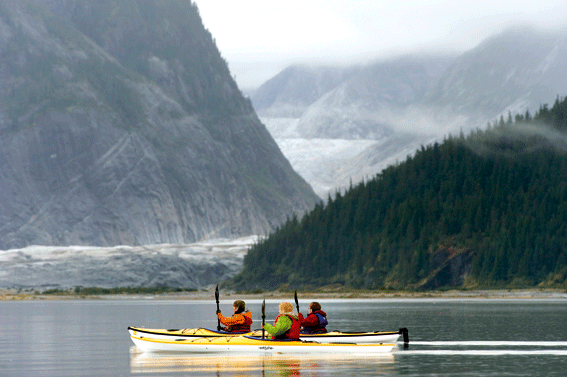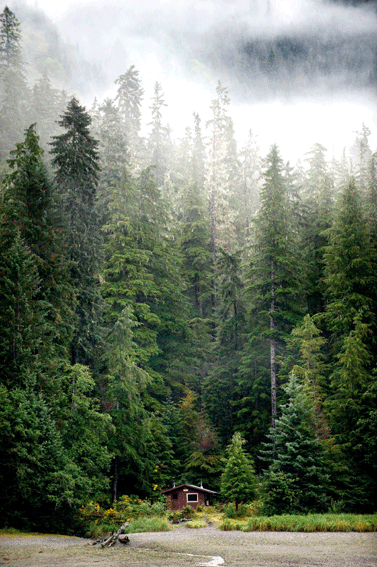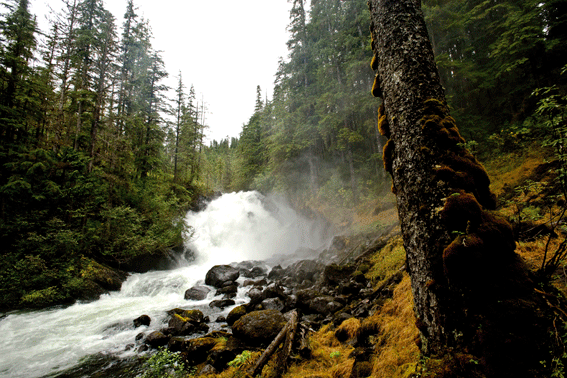
Travel
Alaska
An Amazing Alaskan Experience

As I lifted my kayak paddle out of the waters of Thomas Bay in Southeast Alaska, I paused for a moment to listen to the soft susurration of rain on the surface of the water. Gossamer veils of fog lay over the dark spruce and hemlock hills that disappeared in the mist above me. In the background, the roar of Cascade Creek provided a constant backbeat, a reminder that this part of Alaska really is a rain forest, getting more than 100 inches of rain annually.
By: Amy Virshup *
Photos: Stuart Isett
It’s a good climate for ducks, and later, back at our cabin perched on the pebbled beach of the bay, I watched a line of waterfowl paddle by, diving under the water then coming up with fish in their beaks. Tilting their heads back, they slid their catch down their long necks.
My husband, my son and I had arrived at the cabin earlier that day, on a water taxi out of Petersburg, a fishing town on the northern tip of Mitkoff Island, in the Inside Passage of Alaska, about 16 air miles southwest of our destination. Air or boat was the only way to get there, which was just the way we wanted it. In planning my family’s trip, I had been looking to get off the grid, somewhere without roads or electricity or other tourists, so that we might really experience Alaska on its own terms. But with a 9-year-old whose camping experience was limited to a few nights in a tent in our front yard, backpacking into the wild seemed impractical.
Then, browsing online one night, I’d stumbled across the idea of renting a public-use cabin. These are simple backcountry accommodations offered by various state and federal agencies in Alaska at bargain rates – about $35 a night. A cabin, unlike a tent, has a roof. And a wood stove by which to dry our supposedly waterproof boots. And hooks to hang all our newly purchased L. L. Bean rain gear. The one that caught my eye, Cascade Creek Cabin, was in the Tongass National Forest, a swath of 17 million largely roadless acres. The online description promised “Berry picking and wildlife viewing,” plus a hiking trail with “access to waterfalls, a whitewater canyon, pristine lakes and alpine areas frequented by mountain goats.” I signed us up.
And so, at 8 a.m. on a misty morning, the three of us headed out for our two-night adventure. We were toting sleeping bags and pads, a camp stove and cooking gear, food for three days – including halibut we’d caught on a fishing expedition the previous afternoon – and a supply of fresh water. On top of the boat were the two kayaks we had rented for our stay. Scott Roberge of Tongass Kayak Adventures, who had rented us the gear and who was dropping us off at the cabin, added to our pile a bag of spray skirts, life vests and other kayaking supplies, including an emergency kit and a radio we could use if disaster struck.
Like hotels, cabins have check-in times, and we pulled into Thomas Bay well before our scheduled noon arrival. As we motored up, we could see the trim brown cabin sitting at one end of a half moon of pebble beach; at the other end, Cascade Creek tumbled into the glacial gray waters of the bay. A skiff was moored in the water out front, and smoke curled from the chimney. The previous night’s guests were still in possession, so we dropped our bags outside and decided to check out the Cascade Creek Trail at the opposite end of the beach. As we walked along the beach, a pair of bald eagles flew out of the trees and over the bay. The sleek head of a seal bobbed to the surface to get a better look at us. According to a book of hiking trails I had picked up in Petersburg, the first mile of the trail was rated “easiest,” and we happily made our way along, first on a softly padded trail that led past moss- and lichen-covered tree trunks, and then on a series of boardwalks installed by the Forest Service. Stretched over the boards was a black plastic mesh for traction. That seemed like overkill until we crossed the wooden bridge over a waterfall, where the trail took a sharp turn upward.
It was raining by that point, and the trail alternated between steep sets of log stairs – the Forest Service seems to have been conducting a contest on how many ways you can turn logs into steps – puddles and slick muddy trails that sucked at our boots. My son’s feet were quickly soaked, and at one point I fell and hit my elbow so hard that my entire hand went numb for a good 10 minutes.
After an hour of hiking we hit a big blow-down area, with tree trunks scattered like pick-up sticks across the trail. Gingerly we climbed over the fallen trunks, trying to keep the outline of the trail in sight.
According to the trail description, about two and a half miles in we would reach a junction that would take us to Falls Lake. There we’d find a rowboat that we could take to yet another trail, which would eventually lead us to Swan Lake.
But among the scattered trees, it was hard to know how far we had come – or how much farther we had to go – and our determination was faltering. With the rain coming down harder, we decided to turn back.
By the time we made it back down to the beach, it was a little after noon, and we were greeted by the putt-putt of the outboard motor as the previous night’s tenants headed home. The cabin was ours. We quickly reconnoitered the place: Inside were two sets of bunks – one single, one double – a table and benches, a work counter and a wood stove (there was also a diesel stove, which we left untouched). A small cache box on the exterior wall provided safe storage for food. The front porch looked out over Thomas Bay and the beach.
An outhouse and a woodshed stocked with logs and axes were out back, connected to the cabin by a boardwalk. Blueberry bushes surrounded us. A small stream rushed along to the bay.
We settled in, getting the wood stove going and then propping our boots around it to dry. Earlier tenants had left behind a miscellany of items, among which we discovered a trivia game called Alaska Wild Card. Over lunch, the three of us competed to answer questions about the 49th state and its flora and fauna. “In Southeast Alaska, approximately 80 percent of bald eagles nest in which kind of tree?” (Sitka spruce.) “What does Denali mean?” (The High One.)
A key source of entertainment was the guest register, which had entries dating back decades. Flipping through it, we soon learned that we were hardly the only people to find the Swan Lake trail too daunting. And, as the rain kept coming, varying from a fine mist that barely kissed our faces to a downpour that turned the nearby streams into gushing faucets, we discovered that we weren’t the first to experience that aspect of the Alaskan climate firsthand either. “Rained every day,” wrote one correspondent, who had visited the cabin 20 years ago.
It was hard to know how seriously to take some of the entries. One writer claimed to have found a bear in the lower bunk. A member of the Harr family from South Dakota noted that they had “caught dolly varden, cod and some other fish but no salmon or halibut. Jerry got a bear that I skinned for him. Fun.”
And what had happened to the fur trapper who, in 1997, recorded a tale of woe, with his boat engine quitting, his food supplies gone and no way of letting the outside world know? “I will never leave town again without letting people know where I am going,” he’d vowed.
After our afternoon paddle, we cooked dinner, grilling our fresh halibut fillets over a wood fire that we battled to keep going in the rain.
As a kind of cabin-warming gift, our Petersburg travel agent had given us a slim volume entitled “The Strangest Story Ever Told” by Harry D. Colp. Colp had been a gold prospector in the area in the early part of the 20th century, and in the 1930s he had written up his experiences, but put them aside and never published them. In the 1950s, his wife discovered the manuscript in a box and had it published in a small edition.
As the long Alaskan summer evening waned – we were getting about 16 hours of daylight – we retreated to our bunks, and I put on a headlamp and read aloud from the memoir.
We were visited only by a small cruise boat that motored through the bay, seemingly on its way to somewhere else, and by a set of porpoises that gracefully curved through the water. Even the porcupine that we’d been told had been plaguing the cabin stayed away. Maybe he was trying to keep out of the rain, too.
Things were so quiet, in fact, that we slept in the next morning, then foraged for blueberries in the bushes around the cabin to make blueberry-studded pancakes. The boys chopped wood, splitting the enormous logs in the woodshed into manageable pieces. I read. My son read. We went out for a paddle up the coast headed toward Scenery Cove and Baird Glacier, at the northern edge of the Stikine Ice Field, a remnant of the once vast ice sheets that covered much of North America in the Pleistocene Epoch. If the previous day had been rainy, this one seemed record-breaking, with water falling straight out of the sky and the pure aquatic rush down mountains providing a constant soundtrack.
That night we sauteed the halibut and read about more spooky doings on our peaceful bay.
The last morning after breakfast, the skies lightened, so we went out for a paddle to Ruth’s Island nearby. As we approached the rocky point at the island’s southern tip, a group of curious seals appeared, popping their heads out of the water just feet away from the kayaks and then making a big show of splashing into the bay behind us.
The water taxi was coming back to pick us up at about noon, and as we paddled back we saw that the cruise boat that had motored through the bay the night before was now moored at the far end of the beach near Cascade Creek. As we were loading our kayaks onto the boat for the trip back to Petersburg, a floatplane suddenly came roaring overhead, skimming above the treetops as it came in for a landing on a nearby bay. Moments later it reappeared and taxied up to the cruise ship, no doubt letting off a new group of guests for an Alaskan adventure. That was fine, I thought, but it really didn’t beat a cabin and a wood stove and the soft sound of rain on the roof.
WHERE CIVILIZATION EXISTS ON THE FRINGES OF THE BACKCOUNTRY
When I started planning my family’s trip to Alaska I knew I wanted to spend part of our stay somewhere truly remote, unreachable by road and far from other people. Backpacking into the wilderness seemed daunting (I had read “Into the Wild,” Jon Krakauer’s account of Christopher McCandless’ death in the Alaskan wilderness), but using a cabin as a base seemed to provide the right mixture of getting away from it all and relative comfort.
It was relative, though: While cabins are a step up from tents, they generally have no electricity, indoor plumbing or heat other than a wood or oil stove. They do have bunks, but no mattresses, cooking stoves or utensils. Plan on bringing sleeping bags, pads, a cookstove and cooking gear, and all necessary food and drinking water (or a water purifier). Firewood is usually available, but not guaranteed.
I began with some basic parameters: We were planning to be in Alaska in early August, wanted to travel part of the Inside Passage by ferry and wanted a site with hiking trails nearby. I quickly closed in on the Cascade Creek site, which was within the Tongass National Forest, and booked it after setting up the required free account on recreation.gov. Our cabin was $35 a night, and because I ended up changing our dates slightly, I also had to pay a $10 rebooking fee. Rules put in effect this year allow only one change of date.